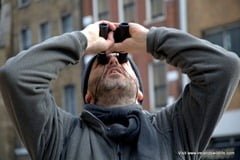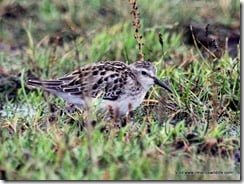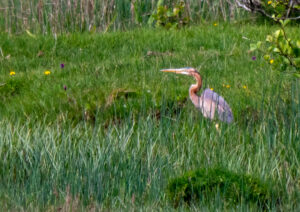 “Look up!” is the catch phrase coined by celebrity UK birder David Lindo, the self-styled “Urban Birder”, and it is, by and large, pretty sound advice. If you find yourself wandering the city streets with time to kill, glancing periodically above your head can reveal some truly remarkable things.
“Look up!” is the catch phrase coined by celebrity UK birder David Lindo, the self-styled “Urban Birder”, and it is, by and large, pretty sound advice. If you find yourself wandering the city streets with time to kill, glancing periodically above your head can reveal some truly remarkable things.
David gained prominence on the BBC’s flagship early evening TV programme “The One Show”, where he had a slot highlighting the delights of looking for and at birds in urban environments. He followed up these successful TV appearances with an autobiography imaginatively dubbed “The Urban Birder”, sharing his experiences growing up in London, and his evolving obsession with wildlife in general and birds in particular. It is a good enough read, although for me it tends to labour the “urban” theme a bit too much. I agree wholeheartedly that there’s more wildlife than you might expect in our towns and cities. Urban environments can harbour an astonishing diversity of habitats and species — but give me the choice and I’ll pick a remote Irish headland, raised bog or native woodland ahead of the bright lights of the big city every time.
Looking up is good… but looking around is better!
That said I do find myself in cities quite regularly, and have followed David’s mantra a few times… most recently on trips to Paris and London. Apart from the very real risk of colliding with pedestrians or careering into lamp-posts, looking up seems to work quite well. If I hadn’t been looking up, for example, I’d have missed the peregrines atop Sacre Couer and the Tate Modern, I’d have missed the hobby engaged in a dogfight with a kestrel over the Les Halles district in Paris, I’d have missed the crested tit atop an urban pine tree near Versailles and I’d have missed the trio of Bewick’s swans flying across London’s iconic skyline.
Most people seldom look up, especially in urban environments, and it is certainly worth considering… but if you really want to experience the wildlife around you in all its glory, then I’d suggest you broaden your scope and adopt my new mantra: look everywhere!
As a wildlife generalist I find looking up a bit limiting. It’s all right if you’re scanning for soaring birds of prey, or hoping to catch fly-by migrants crossing a slim sliver of inner-city sky, but if all you do is look up you’ll miss an awful lot of what’s going on around you. Look up and you’ll miss the delicate orchid growing just off the main footpath. Look up and you’ll miss the otter as it slips into the water from the adjacent river bank. Look up and you’ll miss the astonishing little zebra spider as it stalks its prey on a nearby wall. Look up and you’ll miss the seals just off the beach, and the humpback whales surfacing further offshore.
Hone your nature radar to see more wildlife
Looking up will only ever reveal a tiny sliver of the bigger natural picture. To really appreciate the rich tapestry of life around us we have to pay more attention. By honing our senses to filter out the everyday hum-drum and tune in to the natural back-story, pretty soon it starts to feel like there’s a lot more wildlife around. Usually there isn’t — we’re just starting to notice more of the things that have always been there.
It can be a tricky skill to master at first. Seeing and hearing the things our subconscious has routinely filtered out isn’t easy. You have to force yourself to pay attention, and that takes effort, but with a bit of practice in the garden, in the park, walking to work or on your lunch break you’ll soon find that it becomes second nature. Your subconscious will come full circle, and you’ll start to notice things almost without trying.
Once you cultivate this sense of heightened awareness — this nature-radar, if you like — it’s a wonderfully transferable skill. Every day becomes different, every journey to work, every walk along a familiar path, every visit to the local park. No two trips to a given location will ever be quite the same; there’s always something new to see, hear or experience.
Every time you leave the house is a potential adventure: you might see nothing, but you could see anything at all. So keep your eyes peeled… and by all means look up occasionally, just don’t forget to look down, look around…look everywhere!
First published in the Natural World column in the Weekend Magazine of the Irish Independent on Saturday 12/05/2012









2 comments
Kevin Kretsch
I’ve been living in Paris for 12 years. Kestrels and peregrines are ‘common’ if you know where to look. I’ve heard Tawny owls at night. Smack in the heart of a big city and 12 million people, it never ceases to amaze me!
Paris has lots of small parks but they are pretty boring in general, dominated by a mix of sparrows, wood pigeons and feral pigeons. The regular garden passerines we’d be used to in Irish gardens (tits, finches, robins, dunnocks, etc.) are around but much more timid and spotting them in Paris parks takes some effort, which is actually fun! In fact it also puts a premium on learning your birdsongs! I’ve also seen Tree Creepers and Black Redstarts.
As you said, it’s about cultivating heightened awareness, turning into a habit, rather than the habit being not listening or looking.
Calvin Jones
Thanks for the comment Kevin. Spent a couple of weeks in Paris around this time last year and had a great time “urban birding” my way around — I only had my pocket bins with me (Ryanair space / weight restrictions) but still managed a decent enough tally. Peregrines on Sacre Couer and the Eiffel Tower, green and great spotted woodpeckers from the apartment balcony, crested tit on the walk to the supermarket. The best was probably the kestrel and a hobby tussling with each other over Les Halles… but there were plenty of other highlights.
There’s more about that trip on the pocket Opticron LE Aspheric review that I wrote when I got back.
Keep looking!